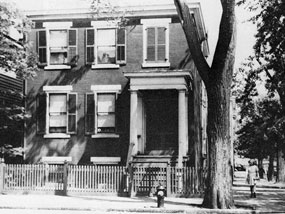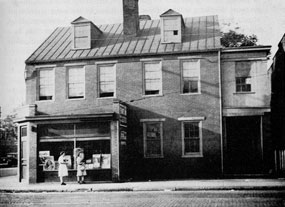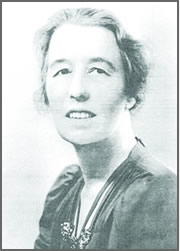RECENT COMMENTS
Mary Wingfield Scott’s Old Richmond Neighborhoods
I picked up Paul Clemens’ Made in Detroit and Mary Wingfield Scott’s Houses of Old Richmond at the library on 25th street yesterday. I’d heard an interview with Clemens on NPR a while back and his story of growing up in Detroit during the demographic and economic changes of the 1970s and 1980s is interesting. Scott’s book is beautiful, but not as beautiful and weird as her Old Richmond Neighborhoods.

801 North 24th Street (built 1855)
Old Richmond Neighborhoods, published in 1950, is a wonderful history and photographic tour of a number of the city’s oldest neighborhoods. Moving from east to west, the beginnings and histories of areas such as Church Hill, Union Hill, Court End, Oregon Hill, Sydney, Catherine Street and many more are given a run down and some photographic examples.

2239 Venable Street (built 1850)
The pictures in the two Mary Wingfield Scott books are fantastic. Each is accompanied by the address and the year built, and all too often by the year that it was demolished. The section on Union Hill has pictures of a few houses that are still standing, most of which are occupied and in good shape. There is a breathtaking picture, though, of the empty house at 801 North 24th Street from back when it was solid and viable home (then
/now). The moments of recognition brought on by these pictures is a rush. Poignent, too, is the overlapping second between almost recognizing the building in photo and then realizing that it was demolished 60 or 80 years ago. The East End and Jackson Ward have a number of photographed houses still standing, while Oregon Hill and Sydney are not recognizable.

Mary Wingfield Scott
As fantastic and as enduring as the photographs are, Scott’s writing is surreally dated. The text is super race conscious and seems to observe whenever an area became occupied by “Negroes”. Writing about the 2300 block of East Franklin, Scott notes that few groups of houses this old exist in the city and that these particular houses were built in a time when very few (“hardly a dozen”) new houses were being built in Richmond each year. This interesting observation is followed by her lament that such fine houses had come to be “rented to a low grade of negro tenant” (Old Richmond Neighborhoods, p.39). She goes on to refer to Gilpin Court as a “Negro housing project”.
Scott’s books are unique and provide more than just the documentation of some old buildings and neighborhoods. If you like old houses and/or Richmond, they will be fascinating. I can only wonder at what Scott would’ve done with the ease of a digital camera and a blog.






Just looking at my poor old house and mentally reviewing the damage that car did. I’m working with the insurance company and hope to start putting it all back together in a few weeks. Got a bit of tape to cut through…not that yellow kind that’s still there but the red stuff.
There are photos of 801 North 24th Street and 2239 Venable Street in the 1965 Richmond Esthetic Survey at the Library of Virginia site.
The links from this post are simply amazing. I found my house (1965) and the one next to it in the Richmond Esthetic Survey. It is worth a gander.
How would one go about securing a copy of the book?
I’ve seen copies at Black Swan on Main Street (they have *great* Richmond/Virginia stuff) and at the Valentine Museum gift shop.
Thanks. I just picked up the Third (1984) Edition at the Valentine Gift Shop for $19.95 – I thought it would be much more for a hardback with all those amazing photos and history.
Another book worthy of finding a copy of is The Architecture of Historic Richmond, by Paul S. Dulaney. Published by The University Press of Virginia. My copy says it was published in 1968, it is my understanding that it is out of print but perhaps you can find a copy at a used bookstore (or maybe the Valentine has it, I haven’t looked). It’s smaller than Ms. Scott’s books, and my copy at least is paperback, and it doesn’t list as many houses as Scott did, but it’s still pretty interesting from the architectural, historical and photographic standpoints. It covers several areas (Church Hill, Shockoe Valley, etc.). Little photos and blurbs on different buildings.
thanks Celeste. I am on the hunt.
The top house is very nice.
Re: The Architecture of Historic Richmond, by Paul S. Dulaney… you can also pick up used and sometimes old-new books on Amazon.com. I got a new copy of the above title that way for about $15 last year.
Eric
bill, the top house IS very nice.
Keep in mind in her day the word ‘negro’ was word used. Not considered racist at the time.
I get the context for her vocabulary, her references to and emphasis on race is of her era. This text is a solid example of how much has changed in the past 50+ years.
With usage, her vocabulary illustrates the attitudes of the day. Would any modern equivalent not sound off in the phrase “rented to a low grade of negro tenant”?
I once purchased her book at a fles market enjoyed the book loaned it to a friend and never seen the book again. I would like another copy but so far I have not been able to locate another copy.
I have an extra copy if you would like it. Call me at 216-3100
FYI, we did a book “Winkie” on Mary Wingfield Scott last year as a private printing. Please find a PDF of the book at http://www.rosegill.com.
And I am also working on “Project Winkie” which is bringing back her two books as digital books. I met with the Valentine Museum about this on Friday, and when finished, these will be available on their website. I would welcome any help and contributions. See “Project Winkie” at http://www.rosegill.com, where I will be posting things as we go along.
Hey Alfred, thanks for the heads up!
We *love* MWS around these parts: check the tag: /tag/mary-wingfield-scott/